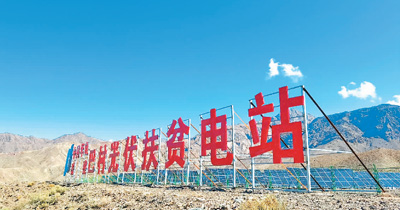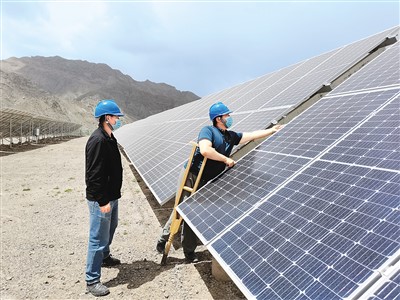Photovoltaic power stations in Xinjiang help villagers secure livelihood
Photovoltaic (PV) power stations in northwest China's Xinjiang Uygur Autonomous Region have helped expand the collective economy in villages and raise villagers' incomes.
Waq-Waq village in Suntagh township, Artux city of Kizilsu Kirgiz autonomous prefecture in the region is one of the places that have developed from the development of PV power projects. The village used to suffer frequent power cuts as it had little collective income to pay for electricity.

Photo shows the 500-kW village-level PV power station in Baykurut village, Wuqia county, Kizilsu Kirgiz autonomous prefecture, northwest China's Xinjiang Uygur Autonomous Region. (People's Daily Online Overseas Edition/Qiu Haifeng)
But in 2019, it piloted a PV power project when Xi Kewei from China Huadian Cooperation Ltd. (CHD), a state-owned power generating group, began to serve as the first secretary of the village Party committee.
The village is covered by sunlight for 2,500 to 3,000 hours a year, Xi said, explaining the reason for developing the PV power project. In August that year, a 70-kW PV power station was put into operation with CHD's assistance.
The PV panels on the roof of the village Party committee's office building guarantee power supply to the committee and surrounding villagers and save 100,000 yuan (about $15,649) in electricity costs each year, Xi said, adding that surplus PV power can also be sent to other places to help the village earn more collective income.
Xi explained that the power station also has a storage system with a capacity of 30 kW, making it the first village-level PV power station with this kind of system in Kizilsu Kirgiz.
Now, CHD has expanded the installed capacity of PV power stations in the village to 110 kW, Xi noted.
Apart from building PV power stations, CHD has also trained its own maintenance personnel for village-level power stations.
Baykurut village of Wuqia county located in the far west of the autonomous region is home to the only 500-kW village-level PV power station in Kizilsu Kirgiz, which was connected to the state power grid on Oct. 31, 2019.
Turghun Qurban is the head of the power station. In June 2019, Qurban and two college students in the village attended a three-month maintenance training course organized by Huadian Xinjiang Power Co. Ltd., a subsidiary company of CHD. After the course, professional personnel offered maintenance guidance to them for one year until they were able to independently carry out their work.

Turghun Qurban (1st R) checks Photovoltaic panels. (People's Daily Online Overseas Edition/Qiu Haifeng)
In recent years, the company has invested 5.42 million yuan in maintenance training in Artux city and Wuqia county, and trained 5,040 technicians and 1,474 grassroots managers. This year, it will also inject about 1.3 million yuan into the training of technical personnel.
PV projects also bring better lives to local villagers. Statistics show that the power station in Baykurut has generated over 1.3 million kWh of electricity and brought a collective income of more than 1 million yuan for the village, which has helped to lift 206 households out of poverty and laid a solid foundation for the village to achieve rural vitalization.
Baykurut has created various public service jobs, including sanitation workers, road maintenance workers, and traffic management assistants, for residents who used to depend on animal husbandry to make a living, according to Chen Dawei from CHD, first secretary of the village. Part of the income from the power station is used to pay the salaries of these workers, Chen added.
Bahtinur Memettursun, who regularly cleans solar panels, has benefited a lot from his public service job. "I can earn about 25,000 yuan each year from the job and more than 20,000 yuan from animal husbandry," Memettursun said happily.
This year, Baykurut will also invest more to develop other industries, including animal husbandry, crop farming, and aquaculture farming, to further expand the village's collective economy and help more residents increase their income, Chen explained.
Photos
Related Stories
- Experts say change for nature will spur better development
- Gigantic centralized PV project glitters in NE China
- Photovoltaic power generation alleviates electricity shortage, helps poverty reduction in Chinese village
- China leads world in new installed photovoltaic capacity
- China exports more photovoltaic products
- Chinese photovoltaic industry thriving despite US tariff
- China warns India after it launches a probe into photovoltaic products
- China tops the world in installed photovoltaic capacity
- China overtakes Germany in installed photovoltaic capacity
- China likely to rank No.1 in terms of photovoltaic application
Copyright © 2021 People's Daily Online. All Rights Reserved.










